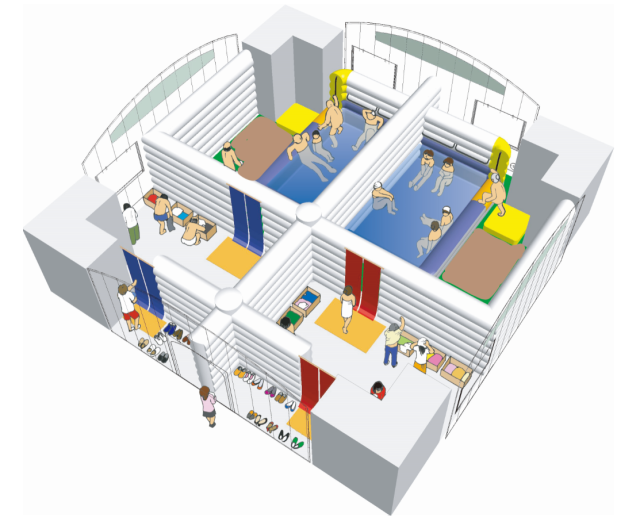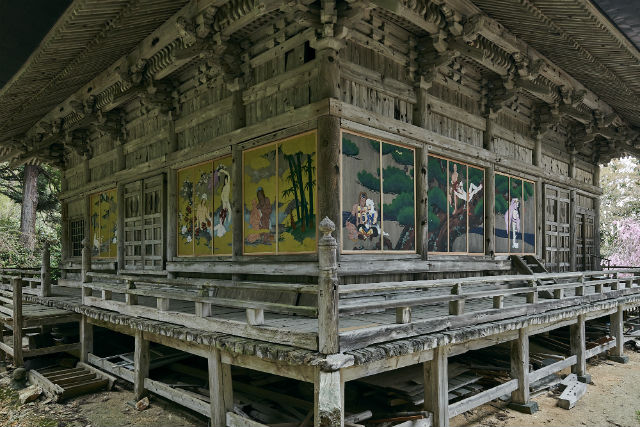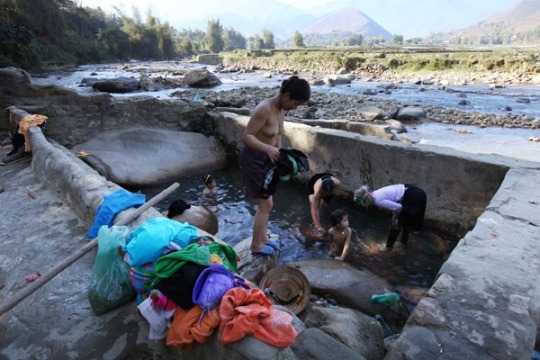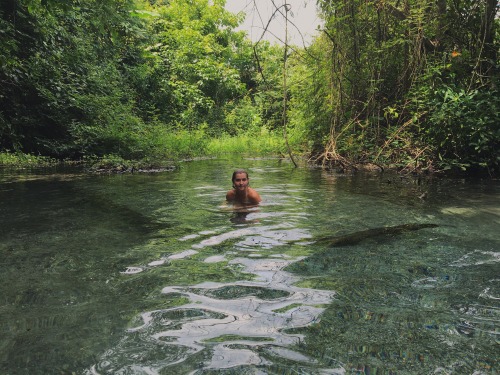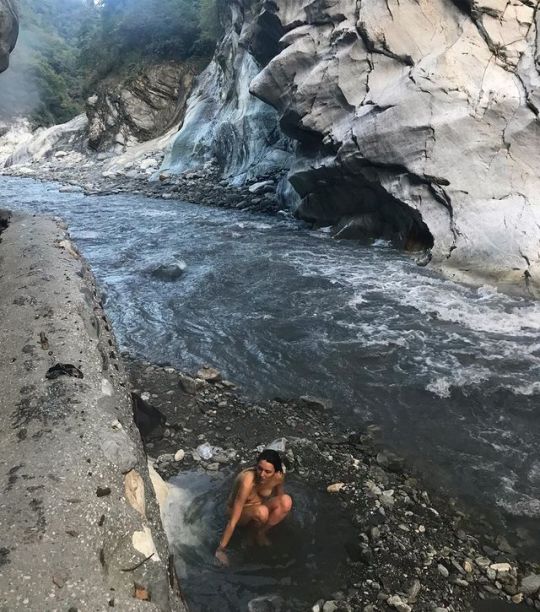Little known fact, Hsipaw's hot springs are conveniently located next to the local motorcycle wash.
Much is to be said about what will happen once the Corona crisis abates. The same also applies to the world of wellness & travel.
Starting off with Global wellness trends for 2021. A bit late, but nonetheless as much of the world is still locked up, pretty much a prediction for what the hordes (read ourselves) will do / go when cut loose.
Little newsworthy trends, basically same same as always just described differently. If anything it will be still very much elitist.
No. 9 on the list with some relevance:
'The coronavirus pandemic acted as a near complete brake on travel in 2020 and consumers and suppliers looked to rebooting travel for the better. The next trend? Look for all travel to become wellness travel as manic getaways are replaced by slower, closer and more mindful experiences. The over tourism epidemic will be challenged, tentative travel will become a new buzzword, and people will strive to leave a place better off than they found it'.
As said, when we are all set loose again, slow travel will not survive. The pressure we exert on each other for new experiences, for greener pastures will trump the slower travelling and experiencing trends. The time we missed, the eventuality that something so weird may well happen again will mean that we have lesser time to see (and experience) whatever landmark still on one's bucket list.
I suspect home wellness will become more and more important. Why rely on seeking commercial facilities located further away when you have virtually the same experience at home? And you determine your own times and rules!
The Sydney Morning Herald (Jan. 5) has its own list of wellness trends:
'With the coronavirus pandemic shaping our entire world in 2020, it's no surprise that we'll see its influence extend into 2021 lifestyle and wellness trends.- Comfort craftingIn terms of mental wellness and self-care, Dayna Isom Johnson, Etsy's trend expert, says "little luxuries" and "wellness-focused rituals" are going to be popular. This includes things as simple as reinvigorated fitness routines and long baths. Another trend that Johnson predicts will "really stick out" is comfort crafting."It's really a time to craft, to learn a new skill and it can certainly serve as a form of self-care and grounding," she said....- Friluftsliv, which translates to English as "free air life," is an appreciation of being outdoors and incorporating outdoor activities into your life....- Trampolines...- Slow travel'.
No news.
A more regional look.
The current (Covid-19 induced) crisis is one in which national tourism agencies seem to be trying to reinvent themselves.
Here, Couchfish (Feb. 26) discusses how Thailand hopes to move ahead, basically by focussing on the high end of clientèle:
'At least within a Southeast Asian context, much of the focus is on “high value” tourism rather than backpackers. By high value, what tourism boards really mean is “high–spending”. This is a mistake—budget travellers are the biggest spenders of all....I’m not arguing that high end tourism should be consigned to the scrap heap—tourism comes in many flavours, and each has pros and cons. Backpackers though punch above their weight and it is folly by tourism boards to (at best) ignore them or (at worst) tell them to stay away'.
It doesn't seem that the local Southeastern Asian governments are grasping reality.
Terakhir ke sini tahun 2009. Not bad!
Soothing
Talking about reality, TravelandLeisure (Dec. 12) presents
'The worlds most instagrammable hot springs'.
Europe gathers most hashtags (f.i. Blue Lagoon), closerby NZ gets 2 mentions, Oz 1 and Japan 2. None in Southeast Asia.
It actually refers to an article put together by Parkdean Resorts which has a more extensive top 25 (again nothing from SeA!) and describes the methodology which compiled data on November 2020.
No doubt the method has its limitations, as it not really incorporating other languages / scripts. But probably the less biased, though it would have been great to compare to a year before.
Several mentions should have been non-starters:
- Mammoth hot springs (US) refers to an area with a fair number of hot springs,
- Aquadome and Termebucuresti are not really natural,
- Cascate del Mulino made it to 20, but the same place but referred to as Termi di Saturnia made it to no. 6,
- Jigokudani, gets the numbers of Jigokudani monkey park whereas
- Sawtooth National Forest actually may have a hot spring but the expansive name includes many, many non-soakers.
So a good effort but needs improvements ...
The NZHerald (Jan. 7) has a national list of (only!) 5 geothermal hotspots.
JapanToday (Dec. 23) has a ranking of Japans most popular hot springs:
'Travel company Jalan surveyed 13,342 users and asked them about their favorite onsen areas, the ones they liked so much that they want to go back, and they all seem to offer much more than just soothing hot waters and Japanese ryokan inns....For the 15th year in a row in Jalan’s annual survey, Hakone, just an hour and a half outside of Tokyo by express train, was voted to be the best onsen resort area in the country. There are a lot of reasons why Hakone is a popular tourist destination, not least among them the startlingly beautiful proximity to Mt Fuji. And with plenty of things to do there–ferry boat rides, a cable car over a volcanic mountain, a scenic railway, shrines temples, and museums, just to name a few, there’re lots of reasons to love Hakone enough to keep coming back over and over again.That Hakone made the top spot once again isn’t entirely surprising, though it is interesting that the top 10 remains largely unchanged since last year, except for Kurokawa Onsen, which jumped up two spots. Perhaps that’s because travel was limited due to the coronavirus, or perhaps that’s because these places are just too good to pass up. Either way, if you’re looking for an authentic, fun, and memorable onsen resort experience, look no further than one of these top places'.
Locally, 8 best hot springs near Manila (by viatravelers (Dec. 19)), though the definition of 'near' may need some explanation.
Traverse-blog (Mar. 1) on how to experience your first time at a Japanese onsen. Nothing surprising though.
Desperate times? The Mainichi reports (Oct. 30) on the slowing business of onsen hosting:
'NISHIWAGA, Iwate -- The local government of this northeastern Japan town, known for its hot spring resorts, put seven of its 10 municipal spa facilities on sale following falls in visitor numbers, but as of Oct. 29 -- the day before the deadline to register interest -- it had yet to receive a single application....Conditions also apply: for at least five years the buyer must operate the hot spring facility and cannot resell the property in the period.Nishiwaga's local government started to build municipal hot spring facilities in the mountain town from the 1980s, and it has aimed to develop the town as a spa resort location. But the town has been hit by serious depopulation in recent years, and the number of visitors has continued to decrease'.
NZHerald again (Jan. 25), hopes yet another article on the (n)on-goings at Waiwera Thermal Resort (not so long ago one of NZ's bigger waterparks):
'The iconic Waiwera hot pool complex closed its doors for a $3 million renovation in February 2018 and has never reopened.Instead, the past two years has seen court battles over rent and trademarks, liquidations, cancelled leases, and a realisation that the damage to the infrastructure of the 50-year-old water park (and its more recent bottling plant) is so bad almost nothing is salvageable....But there's a potentially happy ending to the tale: the present owners in September 2020 made preliminary decisions on a $250m masterplan.....They say the whole project could take as long as 10 years'.
Blessed
Friday. Pool day 🐟🐟Ready for water game 🐰🐰#alxforever #holiday #holidays #2020 #travelblogger #travelphotography #asia #laos
A new Laotian soaking opportunity (photo above)? A new swish resort in Xieng Khouang. There's not much to find, it's managed /owned by Asa Power company and only has a Facebook page. There's also very few reviews as of now.
FindingHotsprings notes (Jan. 16) Wareerak (Krabi) as its best soaking spot in Siam:
'... you’ll be able to soak in five hot spring fed pools found on the property, of varying temperatures. To determine the healing properties of their springs, Wareerak had the waters tested by the Institute Fresenius in Germany in 2017, and it was found that the waters met the German standard for “Natural Medicinal Water”. Additionally, the waters do not contain any strong sulphur smell. With a PH of 7, the waters are very good for the skin and may be used for drinking as well. A signature of the property is its hot springs waterfall, a true natural wonder'.
A complete guide (Feb. 14) to Sai Ngam hot spring, Pai (Mae Hong Son province - Thailand) by Jonny Melon. Though excessive, by no means complete. And why whine about national park entrance fee?
This was such a happy day for me. It was one of the last days of swimming for me in Thailand because I was getting my feet tattooed the next day. By the time they healed, I would have left the country. So we decided to drive about an hour or so past all of these small villages and into the heart of the mountains. Protruding from the ground was this huge bubbly rock that was spewing boiling hot water from the Earth. The local people built a system to let some of it travel through to two pools for soaking, while the rest just merged with a nearby cold river. It was surrounded by mountains and beautiful nature. We spent hours here, soaking up every last minute. I truly remember being so happy about this decision. Sometimes you have to go out of the way to see some new things that speak to your heart. Was blessed to swim at these hot springs.
The same Jonny also has a recent (Jan. 16) posting on Ardent (Camiguin, Philippines):
'As I mentioned earlier, these hot springs sit at the foot of Mt. Hibok Hibok volcano which is where the thermal water is derived from. The water temperature is around 40°C that is slightly cooled on the way down to the lower pools.Ardent Hot Springs are man-made pools surrounded by lush rainforest and the water is transparent with a tinge of blue. For a man-made structure, they’ve done well to make this place a tranquil experience for visitors.The water cascades from the top of the valley and divided into four separate pools. The two larger pools at the bottom are the most inviting and there is an arched footbridge between them'.
GettingStamped (Feb. 20) introduces everything you need to know concerning Maquinit hot spring.
'Looking for the perfect place to end a fun-filled day in Coron? Consider a visit to the tranquil Maquinit Hot Springs. As the only saltwater spring in the Philippines, Maquinit Hot Springs is fueled by an active, underwater volcano.However, you don’t have to worry about any dangerous eruption. The hot springs are entirely safe. Not to mention, soaking your aching muscles in the warm waters is the perfect way to unwind after a long day of island hopping and outdoor adventure'.
NikkeiAsia (Jan. 9) on a slice of Japan in north Vietnam:
'Yoko Onsen resort lies nestled deep in lush mountain forests in Vietnam's Quang Ninh Province. It has all the trappings a traditional upscale Japanese resort needs, from luxurious ryokan-style buildings to baths bubbling with mineral-rich hot-spring water.Since it opened in June, the new leisure complex has become a hot topic among trend-conscious Vietnamese. It may help spread the Japanese onsen culture of bathing nude for relaxation and wellness in the country, where the closest thing to an onsen is a hot-spring pool to take a dip in while wearing a bathing suit.Yoko Onsen, the first Japanese-style hot spring resort in Vietnam, is a three-hour drive from Hanoi, the capital. It is located off the beaten track and in a beautiful tranquil setting overlooking forests and hills in the karst landscape stretching from Ha Long Bay, a UNESCO World Heritage site....All baths are outdoors. The complex is divided into three zones: separate areas for men and women, and one for both men and women to bathe together in swimsuits.Besides 25 bathtubs, the complex also has bedrock bathing facilities and saunas. The water is rich in sodium and chloride ions, and the temperature of the spring's source is 42 degrees Celsius. The spring water is diluted with no other water.Unlike Japanese, Vietnamese do not bathe or soak with strangers completely naked. When this reporter visited Yoko Onsen, young guests were making a lot of noise in the mixed bathing area. A manager at the resort said it will try to help Vietnamese learn how to enjoy onsens in the Japanese style'.
Sun in my eyes, navy blue skiesThese are the reasons I can survive ☺️#sunset #13degrees
Not often, but a scientific article (pdf, Oct. 9, 2020) on one of the regions hot springs, which for a change does not look at geothermal potential (read how to make money easily), but looks at how the environs of Annah Rais hot spring (Sarawak, Malaysia) can be monetized. !!!
'The Hot Springs has potential to become a tourism destination that can contribute to Malaysian Economy'.
And non-Malaysians were prepared nearly three times as much as locals, suggesting the need for more local education. ?







